“Quality Pays Off”
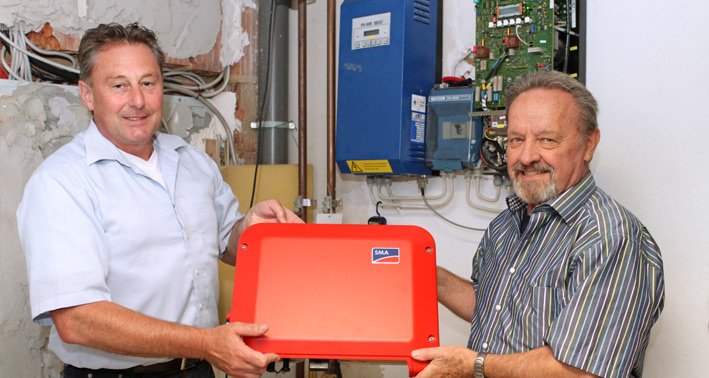
Dieter Frosch’s PV system combines the pioneering spirit of the early 1990s with state-of-the-art technology
Over 20 years ago, Dieter Frosch installed a PV system on his roof. This certainly makes him a solar energy pioneer. And he’s unique in running one of today’s most modern SMA inverters, the Sunny Boy 2.5, alongside one of its oldest inverters, the PV-WR 1800. During a visit to his home, he looks back on the pioneering age of photovoltaics—telling us that he is sometimes surprised himself that his system is still running after all these years, and why he also has old washboards hanging beside the inverters on his walls.
“My PV-WR 1800 isn’t working properly anymore. I hope you can help me.” Dieter Frosch from Vellmar said these words as he stood at the SMA reception in June. That’s where, by chance, he met Frank Illian. Straightaway, Frank’s curiosity was piqued. “As soon as I heard ‘PV-WR 1800,’ my ears pricked up,” explained Frank. “I was fascinated to discover that there was still one in the field. It’s a real piece of SMA history, and I absolutely had to see it.”
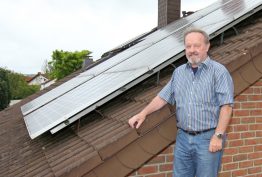
A reliable energy provider right on the roof: Since 1993, Dieter Frosch’s PV system has produced solar power.
1,000 roofs with photovoltaics
To be more precise, the PV-WR 1800 is SMA’s first inverter, which started serial production in 1991. Two of these inverters began operating in Mr. Frosch’s PV system with Siemens modules in 1993. The system, with 3.6 kilowatts of power, cost 86,000 German marks (around 45,000 Euros), an almost unimaginably high amount by today’s standards. To date, it has produced over 20,000 kilowatt-hours of solar electricity. Even PV system operator Dieter Frosch can sometimes hardly believe that the system is still running and almost smoothly. “In the end, quality always pays off!” said Frosch.
Back then, planning and commissioning was handled by Gerd Hackenberg and his company INES Innovative Energiesysteme GmbH. As fate would have it, Hackenberg is now a Senior Expert in Application Engineering at SMA, and he remembers the installation well: “At the time, small, decentralized grid-connected PV systems were still extremely rare. Dieter Frosch’s system was one of the first PV systems in Hesse and just made it into the 1,000 Roofs Program.” This meant that he received a 70 percent subsidy, making the investment a lot more bearable. The aim of the federal and state governments’ 1,000 Roofs Photovoltaics Program—or “1,000 Roofs Program” for short—was to gather experience and knowledge about the planning, construction and operation of smaller grid-connected PV systems (see info box). It was an initial attempt to implement grid-connected solar energy on a larger scale. Up to that point, it was mostly experienced tinkerers with an interest in technology and committed environmentalists who installed PV systems on their roofs.
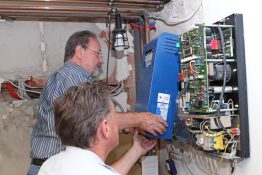
It’s a real rarity: The PV-WR 1800 inverter was the first series-produced SMA PV inverter and it’s still running at Dieter Frosch’s home.
Preserving and passing on knowledge
Dieter Frosch, born 1942, is a combination of both. As a qualified electrician, he was always driven by an interest in alternative energies and the idea of “doing something really useful and sustainable for the environment. Ideally, right on my own doorstep or right behind it.” However, preserving old technologies from the traditional skilled crafts and trades is at least as important to him as his innovative ideas. That’s why he is a passionate collector of old agricultural equipment and tools—flax brakes, spinning wheels, washboards, harnesses for draft animals, clay and stone jars for example—simply to be able to pass on the knowledge of what life was like back then. “Otherwise it will be completely lost to us. What child today still knows what a flax brake is?” Um…I have to admit that I don’t really know either, even though my childhood is far behind me. Of course, Dieter Frosch is ready with the answer: “It was used to break up the flax and to separate it from the hard woody stems so that later on it was easier to spin and could be made into linen. The material conducts heat much better than cotton. If you wear a linen shirt on hot days like today, you won’t suffer half as much from the heat.” [Author’s note: And it really was extremely hot during the visit to Vellmar.]
Combining tradition and innovation
The Frosch single-family home is also a fascinating combination of innovation and tradition. To provide a more solid financial basis for the construction of his house, Dieter Frosch gave up his work as an electrician and swapped it for vocational training in a stable job as a civil servant. Since then, he has spent his free time tinkering and puttering about on his self-built low-energy house. He was particularly interested in the Hofmann voltameter, a forerunner of today’s “power-to-gas” technology. The electrolytic decomposition of aqueous solutions produces gas, which can in turn be used to generate energy. “I was also very interested in having this for our house, but it wasn’t authorized for use in Germany,” said Frosch. “So I decided to use photovoltaics and solar heat instead.” The 800-liter thermal store supplies the Frosch family with hot water from March to November. And, for thermodynamic reasons, almost all the windows are south-facing, and the outer walls have been covered by hand with clinker bricks.
However, the electrician was becoming desperate because he couldn’t fix the fault on the inverter himself. “One of the inverters was sporadically breaking down every couple of days, otherwise the system was still working perfectly. That I am now getting a brand-new inverter has left me almost lost for words. And that doesn’t happen very often,” he smiled, during the “handover” of the new Sunny Boy 2.5. He was quite surprised at the weight—at just under 10 kilograms, the Sunny Boy 2.5 is only about half as heavy as its “great-grandfather,” the PV-WR 1800. Both are now hanging beside each other. “It’s a wonderful piece of history that you have in your cellar,” said Frank Illian. It’s the history of inverter technology innovation.
“1,000 Roofs Program” info box
Starting September 1990, the federal and state governments’ 1,000 Roofs Program used a set quota to subsidize photovoltaics in Germany.
The aim was to “evaluate the existing state of the art” and to “determine the development still required in low power grid-connected PV systems.” Federal and state governments subsidized 70 percent of the system and installation costs (50 percent by the federal government, 20 percent by state governments). In 1991, the program was also extended to the states of former East Germany. In return, operators agreed to read their energy meters every month for five years and to send the values on a quarterly basis to the Fraunhofer Institute for Solar Energy Systems ISE in Freiburg.
Grid-connected systems from German manufacturers (even if the modules were manufactured abroad) in a power class of 1 kW to 5 kW that were installed on roofs of single-family and two-family homes were subsidized. The subsidized systems had to begin operating by 1993 at the latest and had to have a generation meter, feed-in meter and a purchased electricity meter.

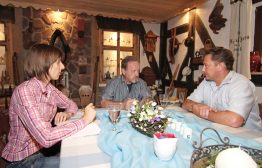
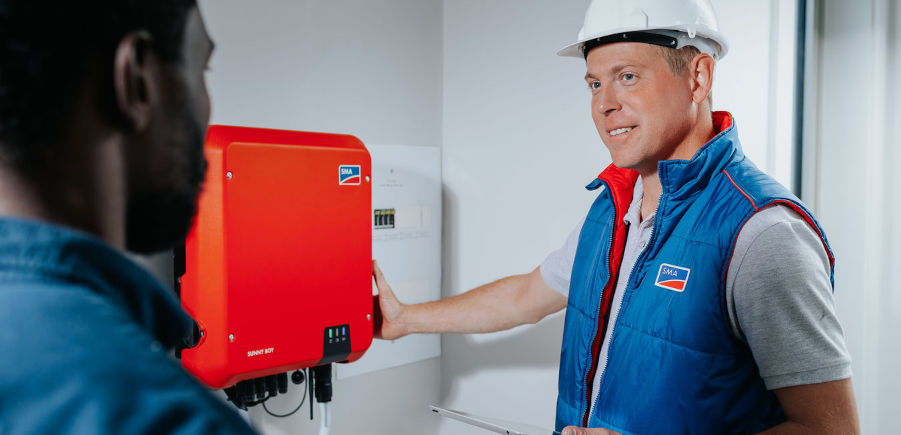
I ask for a off grid course inclusive hybrid solutions. Somebody tell me, that SMA have several courses for free. Can you show me where I find this, on your website
Best regard
Jan Gunner
Racell Saphire
Denmark
Hello Jan,
Here you can find our training offer.
Some of these trainings take place in Niestetal, Germany. For those you have to pay and of course come here. But we also offer Webinars for free.
Just have a look on this page, the dates are regulary updated.
Kind regards, Jennifer
Hi dear friend:
Thanks for your message!
The question is whether Inverter was online without connecting to the Grid and it can be used output.
Your advice was:
THE SYSTEM SOLUTION FOR A SELF-SUFFICIENT POWER SUPPLY
(http://www.sma.de/en/home-systems/solar-system-off-grid.html)
My question is:
Is the solution offered on the site the inverter SUNNY BOY 2.5 and SUNNY BOY STORAGE 2.5 can be used to replace with the inverters SUNNY ISLAND and SUNNY BOY TL ?
Hi Ehsan,
at this moment it is not possible to replace the Sunny Island System with Sunny Boy Storage 2.5 and Sunny Boy 2.5.
The Sunny Island System has got special technical features wich you need for an off grid system. The two other inverters do not have this technical features.
Regards, Annika